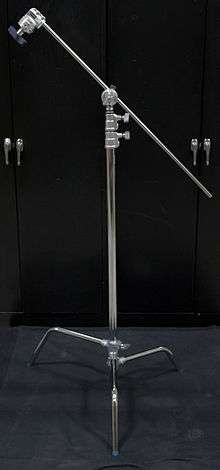C-stand
In film production, a C-stand (or Century stand)[1][2] is primarily used to position light modifiers, such as silks, nets, or flags, in front of light sources.[3] The stand is constructed of metal and consists of a collapsible base, two riser columns, and a baby pin on top. In addition, a C-stand typically includes a gobo head and a gobo arm, also known as a grip head and grip arm[4], which provide the ability to articulate a light modifier without moving the stand itself. The legs of C stands are designed to be nested, so many stands can be placed around a light source.

A secondary use of C-stands is to position smaller light fixtures.[5] A typical use would be to offset a backlight from the stand column, so that the stand itself can be placed out of shot, while the backlight hovers somewhere above the top edge of frame. In recent years, C-stands have found a new use, supporting the brackets used for balancing Steadicam (and similar) camera sleds.
These popular stands are available in many different configurations, lengths and finishes. The unique staggered leg design allows C-Stands to be nested and therefore be placed extremely close to one another on set. The lower leg can also be slid under many objects. The C+ offers a removable base for the risers, making disassembly for travel simple and easy. The sliding leg allows for use on stairs, off curbs and even as high as a desk or countertop.[6]
History
The term C-stand comes from the early history of lighting equipment where a popular sized sun reflector was 100 inches square or "century". The term ‘Century Stand’ goes back to the early days of motion picture production. Before there was artificial lighting the stages would revolve to allow for continuous overhead lighting from the sun. Large reflectors would be positioned to bounce or kick the overhead light up onto the stage and illuminate the set and actors. These reflectors were made in many sizes but it seems the most popular was the 100 inch, or ‘century’, sized reflector. In later years, studios, grips and gaffers began to manufacture the earliest versions of what we now call C-Stands. The original C-Stands had welded bases that did not fold up or adjust but the fact that they easily nested together made them invaluable on the stage.[7] Century Stands or ‘C’ stands are an important component in the image maker’s arsenal of tools.Today the term C-stand is a popular name for the grip stand made by Matthews Studio Equipment, Inc. and has been copied by other manufacturers.
In 1974 Matthews Studio Equipment introduced the industry’s first folding base C-Stand. Matthews produces a wide range of C-Stands and related accessories to assist the motion picture, television and photographic professional in lighting and lighting modification support.[6]
Use
Using a C-stand safely is a matter of proper technique, and on the job training. When setting and tightening a grip arm, flag or other equipment in the grip head, it is crucial that the gear be set to one side of the grip head such that the weight causes the locking knob to tighten clockwise, or "righty tighty".[5][4] Failure to follow this rule will cause the weight to slowly loosen the head, eventually dropping the gear altogether.
Since a stand is used to hold a piece of gear high above or far off to the side, the base of the stand must be weighed down, commonly with sandbags. The bag is slung over the top of the tall stand leg so the weight is fully on the stand and not the ground.[4][5]
Types
A C-stand is sometimes referred to as a "grip stand". The Grip department always—and sometimes the electrical department—carries C stands for use with lights that don't mount onto baby or junior stands, such as kinos.
A "baby C-stand" is only 20 inches at its shortest height. It is nicknamed a "Gary Coleman" or a "Billy Barty" stand in the US. In the UK a short flag stand with stubby legs is called a "shotgun" flag stand (a reference to the stand having been "sawn off").
A C-stand with a removable base is called a C-stand with a turtle base. The opening at the top of the turtle base accepts the base of c-stand upright or a junior pin. Turtle bases are great for setting up a light very low to the ground.[5]
A C-stand with an upper most leg which is moveable on the vertical axis is called a Stair Leg C-stand or a Sliding Leg C-Stand, as the unit can be placed on a stairway. Also called a Rocky Mountain Leg.[4]
A Punky C-Stand is a 20" C-Stand with a smaller base and footprint than the standard 20" size.
C-Stands come in sizes multiple sizes: 20", 30", 40", and 60" - the most common sizes are 20" and 40". They may be chrome or black.
References
- Richard K. Ferncase - (1995) - Film and Video Lighting Terms and Concepts pp 28-30, 39.
- Professional Cine Photographer magazine How to use grip equipment August 1953 p. 325, 338.
- Brown, Blain (2002). Cinematography: imagemaking for cinematographers, directors and videographers. Focal Press. p. 252. ISBN 0-240-80500-3.
- Uva, Michael G. (2009). The Grip Book. Focal Press. pp. 93–98. ISBN 978-0-240-81291-5.
- Box, Harry C. (2010). Set Lighting Technician's Handbook, Fourth Edition. Focal Press. pp. 75–82. ISBN 978-0-240-81075-1.
- "40" C+Stand Spring Loaded Turtle Base". matthewsgrip. Retrieved 2019-11-06.
- "20" C+Stand w/Spring Loaded Turtle Base, includes Grip Head & Arm". matthewsgrip. Retrieved 2019-11-06.